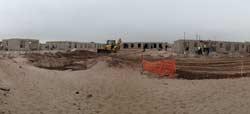Confidence levels among building contractors remain low with a report by the Bureau for Economic Research revealing that a panel of residential and non-residential contractors point to three constraints, namely insufficient demand for building work, shortages of skilled labour and inadequate supply of building materials.

Construction on the first phase at Vanguard Residential Village, an Asrin and International Housing Solutions joint venture started in September and is scheduled for completion in April 2014.
As a result, residential property developers face risks beyond their control once they push the button on a project, read the article here.
According to Absa, there has been a slowdown in residential building activity since May 2013 in the South African market for new housing and this continued to August, after levels of activity have been on an upward trend in the first four months of the year.
August recoded year-on-year (y/y) growth in the number of housing units for which building plans were approved by local government institutions, whereas the number of new housing units reported as completed dropped for the fourth consecutive month y/y in August.
Writing in the report, Jacques du Toit, property analyst at Absa Home Loans, says flats and townhouses remained the major contributor to growth in residential building activity up to August.
The number of new housing units for which building plans were approved increased by only 0.5 percent y/y to 4 613 units in August 2013, although there was an increase of 887 units in the planning phase from the July figure of 3 726 units.
Du Toit points out that the higher number of plans approved in August compared with July was mainly driven by the segments of small houses and flats and townhouses.
The construction phase of new housing decreased by 23.4 percent y/y to 3 044 units in August, while this figure was also down by 551 units from July this year.
He says small houses (-43.2 percent y/y) and flats townhouses (-11.8 percent y/y) mainly contributed to this contraction, while the number of houses completed (larger than 80 square metres) remained almost stable at 950 units in August from 947 units in July.
“The first eight months of 2013 saw the real value of plans approved for new residential buildings growing by 17.3 percent y/y or R3.23 billion to R21.96 billion from R18.73 billion in the corresponding period last year,” he says.

The number of new housing units for which building plans were approved increased by only 0.5 percent y/y to 4 613 units in August 2013, although there was an increase of 887 units in the planning phase from the July figure of 3 726 units.
According to Absa, the real value of residential buildings reported as completed increased by 8.8 percent y/y or R1.2 billion to R14.84 billion in the period January to August from R13.5 billion in the same period last year.
Du Toit says the current declining trend in residential building activity is a reflection of conditions in the economy, household finances, consumer and building confidence and factors related to the demand for and supply of new housing.
The expectation is that these factors will remain important, with residential building activity continuing to be mainly focused on the segments of smaller-sized houses and higher-density flats and townhouses against the background of the affordability of housing and mortgage finance as well as changing lifestyles in general, he explains.
Meanwhile, the construction of the first phase at Vanguard Residential Village in the Western Cape is under way and is scheduled for completion in April 2014.
In a joint venture between Asrin and International Housing Solutions, the development consists of freehold homes and sectional title apartments with only 10 percent of the 135 units still available for sale, says Shiraaz Hassan, Asrin commercial director.
Hassan points out that Vanguard Village continues to be the only lifestyle development available within the affordable segment in the area with a large percentage of buyers being first-timers and owner-occupiers.
Units in this development are priced from R423 895 for a two bedroom apartment measuring 45 square metres and R582 895 for a two bedroom house measuring 60 square metres.
While demand for affordable housing is high, he says many buyers still battle to obtain home loan finance as banks are still strict on lending.
“A concern is that with the credit amnesty coming into effect, most banks have become “risk averse” in granting finance to first-time buyers, especially to those applicants who benefited from the amnesty act,” he says.
Banks are dealing with a lot of “toxic debt” dating back to 2009, and the credit amnesty would just add to their woes, according to Hassan. – Denise Mhlanga









